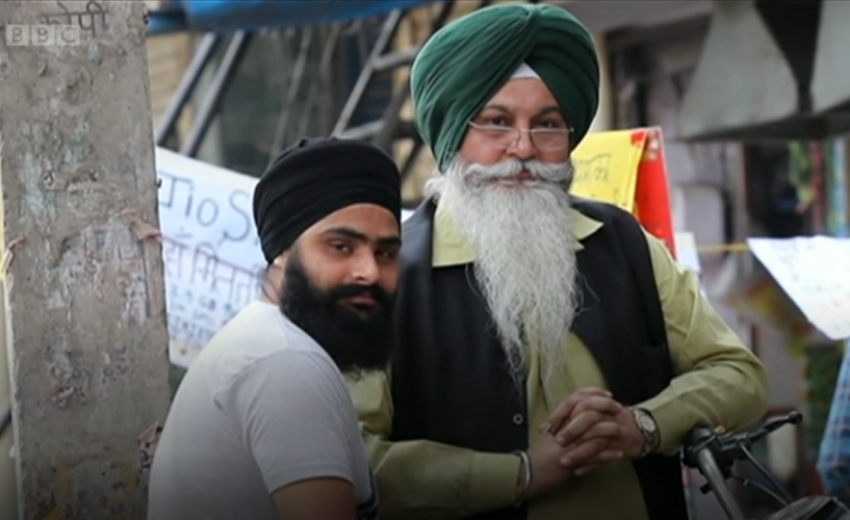On February 24, 2020, the worst communal violence seen in Delhi since the Sikh riots of 1984 swept the city. Mohinder Singh and Inderjit Singh used their Bullet motorcycle and a scooter to transport somewhere between 60 and 80 of their Muslim neighbors to a safe location. They did this while the city was engulfed in a state of chaos.
According to the father and son duo, they were the first to sense that the situation in the predominantly Hindu neighborhood of Gokalpuri in northeast Delhi was escalating out of control. As a result, they began evacuating their terrified neighbors one at a time to the closest Muslim neighborhood of Kardampuri, which is located one kilometer away.
Helping the society
According to 53-year-old Mohinder Singh, his son was riding the Bullet motorcycle and he was on the scooty when they traveled from Gokalpuri to Kardampuri. It took almost an hour to reach the location. Each of them had to make approximately 20 trips. When it came to taking women and children, they would only do so in groups of three to four at a time. The father-son duo would take two or three at a time back when it was only men and boys. To hide the fact that some of the boys were Muslims, they wore turbans similar to those worn by Sikhs.
Mohinder Singh runs an electronic store and is a father of two children. He said that he does not differentiate based on religion. For him, it is not that a person is Hindu or Muslim. He shares, “ I just saw people. I saw little children. I felt like they were my children and that nothing should happen to them. We did this because we all should act humanely and help those in need. What more can I say?”
The Sikh father-son duo stand tall as protectors
Gokalpuri witnessed some of the most heinous violence during the three days of rioting, killing over 40 people. The bullet wound that Head Constable Ratan Lal received ultimately led to his death. This location witnessed the burning and looting of Muslim businesses, homes, and a mosque. The Muslims who fled have not yet made their way back.
The sardars are now famous among the Muslim residents of Kardampuri, who now consider them local heroes. In a city that was in mourning and torn apart by the riots, their story is a rare example of something heartwarming.
Mohinder Singh, who was just 13 years old when the tragic anti-Sikh riots raced across the city, found the violence that occurred over the weekend to be a sickening reminder of the events that occurred in the past. In a time when India appears to be more divided than it has ever been, the remarkable bravery he showed provides some reason to believe that all is not yet lost. He said, “I have lived through the hell that was 1984. Those memories have been revived.”
Story of hope amidst a reign of fear
Five days after a leader of the Bharatiya Janata Party (BJP), Kapil Mishra made a hate speech against people protesting the Citizenship Amendment Act (CAA), which is now regarded as the impetus for the violence, there were very few shops open in the Gokalpuri market on the 27th of February. There were only a handful of stores that were operating.
When asked about what motivated his son and him to make trips and save the neighbors from the harsh treatment and violence, Mohinder Singh smiled, and said, “You have to understand that this is the belief and culture of our community. You may have heard the expression: Nanak Naam chardi Kala, tere bahne sarbat da bhala. Sarbat da bhala means that we want everyone to prosper. We did this to honor humanity and our 10 gurus whose central message is that we should act for everyone to prosper.”
How the riots unfolded
According to Mohinder Singh, who provided a minute-by-minute account of what took place in his neighborhood on that particular evening, the tensions in Gokalpuri began to rise on February 24 at approximately five o'clock in the evening.
It all started with people shouting chants in favor of Prime Minister Narendra Modi and demanding for "traitors" be slain. They also chanted Jai Shri Ram. Gradually, more and more people joined and chanted the slogan across the streets. As the number of people supporting the extremist thought increased, the Muslims of Gokalpuri experienced terror and rushed to their local mosque Jamia Arabia Madinatul Uloom mosque. Later that night, the mosque was burned down and looted. It was a gruesome act that instilled fear among the Muslim community.
Looking at the worsening situation, the Muslims came to the conclusion that they would depart right away. They warned Mohinder Singh that the number of individuals who intended to hurt them was likely to be greater than the number of people who were prepared to risk their own lives to save them. In turn, Mohinder Singh offered them protection and begged them to consider staying behind, but they declined his offer.
The Hindu mob had commandeered the main road outside the locality. The Muslims of Gokalpuri were in fear that they would not be able to make it past them. At that point, Mohinder Singh and his son stepped in and offered to ferry sixty to eighty of them to the nearest Muslim neighborhood.
What Mohinder Singh believes in
Given how rapidly the circumstance was deteriorating, the father and son concluded that there was no longer enough time to get their automobile from the parking lot. They would have to get by with just their motorcycle and their scooty for transportation.
“We don’t think we did anyone a favor,” said Mohinder Singh. “We didn’t do it for praise or thanks. We did it because it was the right thing to do.”
He further added that we did this to honor humanity and the ten Sikh gurus whose central message is that Sikhs should act for everyone to prosper.
A risk to the welfare of society
After driving some of his Muslim neighbors to Kardampuri, Mohinder Singh found that Gokalpuri was engulfed in full-fledged riots when he returned home. He attempted to prevent the rioters from torching the shop of a Muslim that was located just one storefront down from his own, but they would not listen to him. He was concerned that a gas cylinder might catch fire and blow up the entire street and utilized a submersible pump that was located in the community center that was located across the street to put out the fire.
The shops and homes of Muslims in Gokalpuri were looted and torched over two days. It was a dire result of the extremist religious views that people hold. The violence that destroyed homes, shops, businesses, and livelihoods of the people is all because of the extremist views, and how they are fueled now and then.
When a reporter questioned Mohinder Singh about the identity of the rioters he had ordered not to indulge in arson, he said that they were outsiders. A common response by victims and eyewitnesses of communal violence is to cast blame for the violence on "outsiders," particularly if they intend to continue living in the area where the violence occurred.
However, Mohinder Singh paused and replied that he believed that rioters were people affiliated with a certain party, and were outsiders. He added, “They were shouting pro-Modi slogans,”
An interview with Mohinder Singh
A reporter probed over the destruction caused by the looting and torching and asked Mohinder Singh how "outsiders" would know exactly which shops to attack. He just responded by suggesting that it was possible that they were unaware. Mohinder Singh also cleaned out his shop in preparation for the possibility that he would be attacked. Even though he has lived in Gokalpuri for the past 40 years and is the president of the Market Association there, he still has feelings of insecurity.
While Mohinder Singh was proud of what he did, it had been brought to his attention that some individuals believe that rescuing the Muslims was not the best course of action He added that they were concerned that something terrible could happen to them. Amid all the communal hatred, they feared being the next target.
Living by the tenets of Sikhism
At the suggestion of the reporter, Mohinder Singh retraced the path he and his son had taken to Karadampuri to avoid being seen by the Hindu rioters who had taken over the road. In Kardampuri, there were a few persons who were able to identify him as the individual who, on February 24th, had brought the Muslims from Gokalpuri to Kardampuri. A thin boy with grey eyes told him, “We know you here as the man who saved the Muslims of Gokalpuri.”
The Sikh man grinned at the people who had come around to witness him before getting on his scooter, powering it up, and riding away from the crowd.
The father-son duo’s act epitomizes humanity and communal solidarity. This is what Sikhism endorses. The earlier Sikhs were warriors, who protected society from harsh treatment. For the Sikh community, it is their responsibility to be the savior, and protect humankind from all evils.
*Based on an article by Betwa Sharma published on Feb 28, 2020, in HuffPost India.

